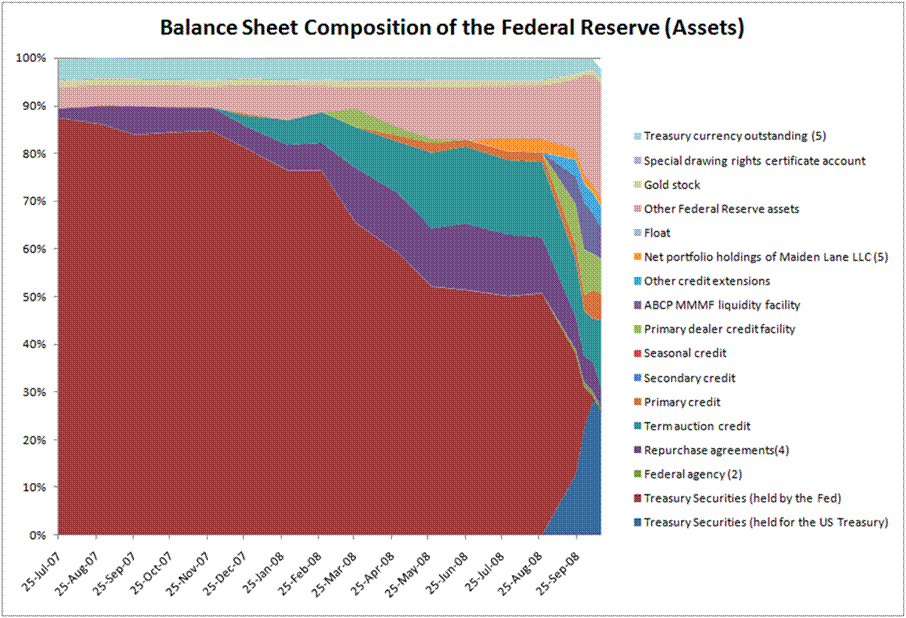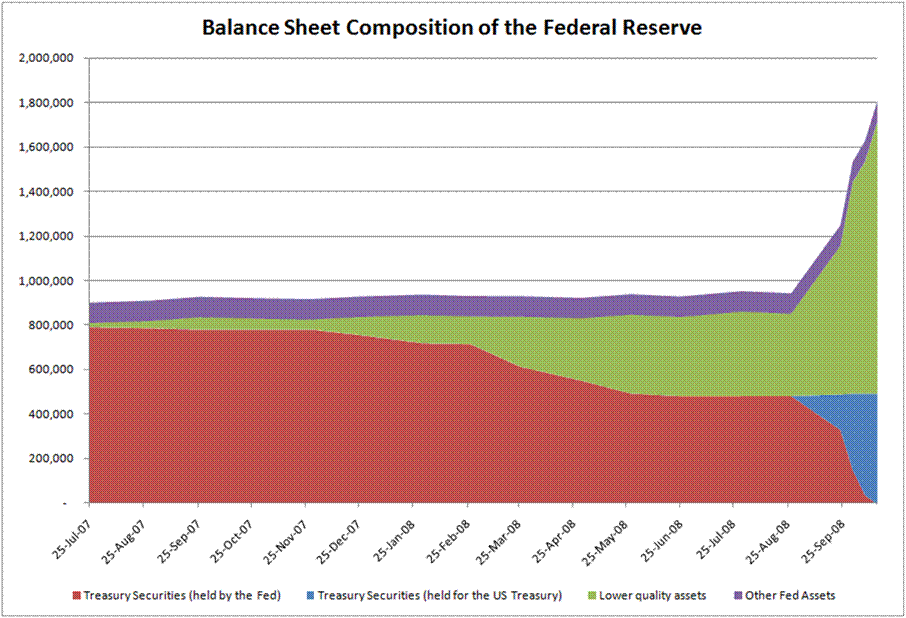There was a great hoo-hah made in the ’90s and early 2000s over the grand importance of having an independent central bank, one that the politicians could not mold to their own ends.? This was largely during the Greenspan era, where the party line was independence, but Greenspan did what the administration wanted, no matter who was president.? Volcker was a better example of what an independent central banker was like, and as such, he was shown the door by Reagan.? Much as I liked Reagan, we would have been better off with Volcker, and better off with someone other than Greenspan.? (Ron Paul for Fed Chairman, baby. 😉 )
I could talk about the social or political aspects of the Fed that makes it less independent of the Government:
- They have worked together in other roles.
- They are grateful for their cushy sinecures.
- The Fed has a too-large employment base that they don’t want to draw attention to.
- There is an aspect of mutual back-scratching.
- No one wants to take abuse from Congress or the Treasury.? Best to go with the flow.
- News coverage always favors loose monetary/credit policy in the short run.
But I’m going to take another approach tonight, one that is more data-driven.? Here’s chart number one of the asset side of the Fed’s balance sheet:
My, but look at how Treasuries owned by the Fed and not sold to them by the Treasury have disappeared.? The most common asset (maroon) has disappeared, and has actually gone negative.? Here’s a simpler version of the graph:
Without the Treasury selling the Fed Treasury securities, the Fed would have run out of Treasuries with which to support its market intervention programs.? They are economically dependent on the Treasury.? That may have impact on their future decisions, not that the Treasury would want to ruin the Central Bank, after all they take care of the extra-constitutional stuff that the Treasury can’t.? Besides, it allows the Treasury to finance the government cheaply by issuing the Treasuries to the Fed.? The relationship is symbiotic.? What could be happier?
I’ve made the comment before that we are heading down the path of Japan with a few differences.? The differences are summarized in my pieces Liquidity for the Government and no Liquidity for Anyone Else, and Inflation for Goods Prices, Attempted Inflation for Housing-Related Assets, but Sorry, No Inflation for Wages.
Where we vary from Japan’s path of quantitative easing is that the money created from government credit in Japan was pumped into the banking system as a whole. In the US, it is pumped into the Fed’s plans to fix various lending markets. This article from The Economist has a good discussion of the similarities and differences.? Whether that will result in fixing those markets, or result in the Government/Fed becoming the one sole counterparty for those “markets” (with a difficult disentanglement) remains to be seen.
In a financial crisis, there are no good solutions.? The good solutions existed 7-20 years ago when orthodox central banking was replaced with tinkering, through oversupply of liquidity in minor problems that should not be called crises, which allowed investors to build up the level of leverage, because the Fed always came to the rescue.? Also, many Fed Chairmen of the past (in the 50s, 60s, and Volcker) stood up to the Adminstration and Congress, and did not enable their policies.? The economy was healthier as a result in the intermediate-term.
I’ve also said that Fed policy works through stimulating healthy parts of the economy, and that pulls the sick parts of the economy out eventually.? Well, because of the overleverage of the past, there are no healthy parts of the economy to work with.? I wish I could be more optimistic here, but given the path that the government is taking, I see the explicit debt of the US Government going to 100%+ of GDP before the system stabilizes, just in time to leave us overleveraged for our entitlements crisis.? At least the debt is denominated in US dollars. :(? How long will our lenders continue to honor that?
We face painful choices over the next 20 years partly as a result of the policies of the last 20 years.? 20 years of pain… hmm… that sounds like Japan as well.? Let’s pray for a better outcome.



I agree with Ron Paul for Fed 🙂 I’m going for the CFA, too. Good luck with your awesome blog (it’s a lot better than that beat guy’s blog at the WSJ).
Painful choices have never been the forte of our leadership. The recent bailout is a perfect example. They insisted that they had to do something. While most of them thought the Paulson proposal was a poor plan, they voted for it anyway after enough pork was added. Real leadership would have told Paulson to get bent and then made their own bill with the contributions of many experts (hopefully not a bunch of bank executives).
The Paulson plan was so bad that having a 700 billion “stimulus plan” where they mail everyone a $2800 check (like the 600 that came in the spring) would have been better. It’s pretty hard to come up with something worse then simply mailing everyone money, but Paulson and the Congress found a way.
What do you think of the rumours of Volcker as Sec Tres for an Obama White House?